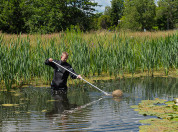Search
Filter by
Type
Tags
Dossiers
Themes
Departments
Active filters
1043 search results
Search results
-
Cookies
TODO -
Aquatic Ecology
Our mission is to understand aquatic ecosystems, predict their responses to a changing world, and contribute to a sustainable future.
-
Symposium success reveals huge potential of rewilding
09/12/2020 With over 2000 participants, the enormous interest in last week’s Rewilding Symposium shows that rewilding is being increasingly embraced as a progressive approach to conservation.
-
The taste of soil fungi
This summer I grew potato plants in my experimental containers. Potato plants are famous for producing potatoes and at the end of the summer I was left with kilos of them.
-
National Science Agenda: how do we keep our biological clocks healthy?
27/11/2020 Dutch researchers joining forces in the BioClock consortium - including NIOO's Kamiel Spoelstra - have won 9.7 million euros to keep our biological clocks healthy.
-
Plant roots grow towards soil fungi
16/10/2020 Plant roots not only release odours themselves, but also appear to react to odours released by beneficial and harmful fungi in the soil. In her PhD research at NIOO, Kay Moisan found that this 'sense of smell' has a positive effect on the eventual health of the plant.
-
Centre of Excellence launched at Naturalis Biodiversity Gala
02/10/2020 At the Naturalis Biodiversity Gala, NIOO-director Geert de Snoo presented the new Centre of Excellence for Netherlands Biodiversity Research: a joint venture that brings together four leading Dutch knowledge institutes.
-
Potatoes are ready!
I set-up the main mesocosm experiment in the containers using sterile soil as background and 4 donor soils with varying levels and traits of fungi.
-
Arctic migratory birds project wins Netherlands Polar Programme funding
28/08/2020 The Dutch Research Council (NWO) has awarded funding to Bart Nolet's project 'Arctic migratory birds over the edge?'
-
High time to open up ecological research
29/07/2020 An international team of ecologists found that only a quarter of the scientific papers in their field publicly shares computer code for analyses.
